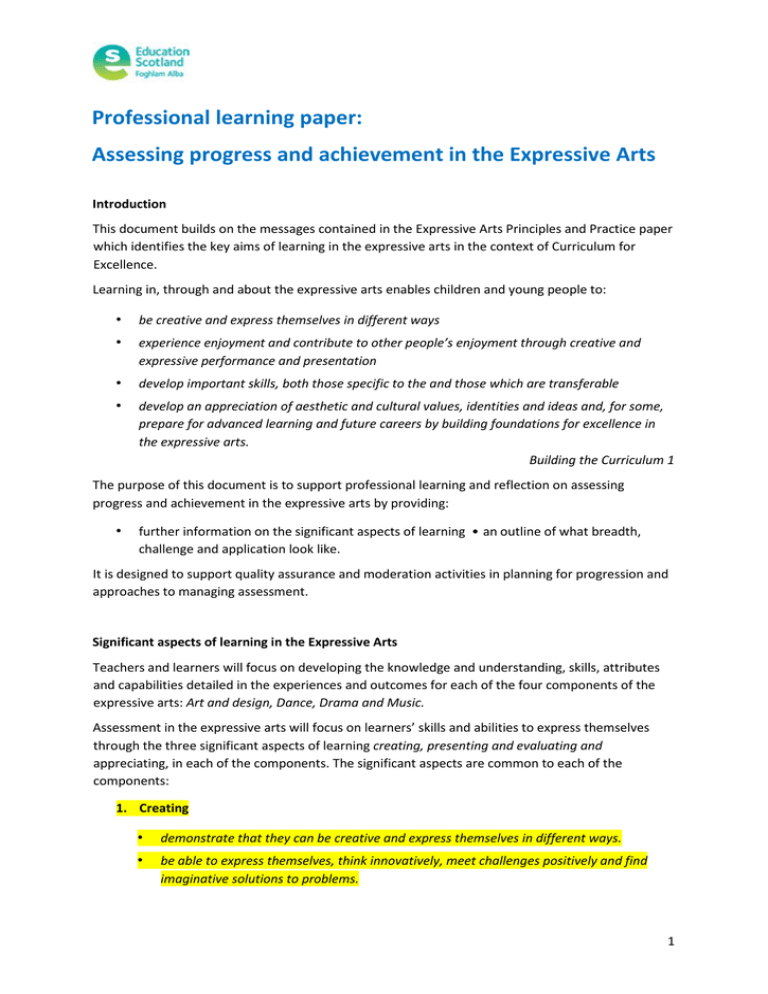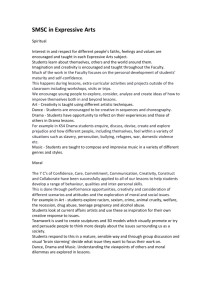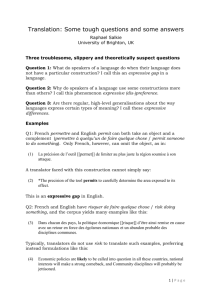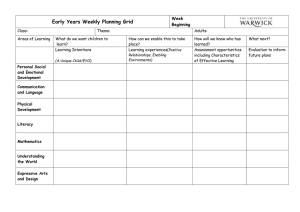Professional learning paper: Assessing progress and achievement in the Expressive Arts
advertisement

Professional learning paper: Assessing progress and achievement in the Expressive Arts Introduction This document builds on the messages contained in the Expressive Arts Principles and Practice paper which identifies the key aims of learning in the expressive arts in the context of Curriculum for Excellence. Learning in, through and about the expressive arts enables children and young people to: • be creative and express themselves in different ways • experience enjoyment and contribute to other people’s enjoyment through creative and expressive performance and presentation • develop important skills, both those specific to the and those which are transferable • develop an appreciation of aesthetic and cultural values, identities and ideas and, for some, prepare for advanced learning and future careers by building foundations for excellence in the expressive arts. Building the Curriculum 1 The purpose of this document is to support professional learning and reflection on assessing progress and achievement in the expressive arts by providing: • further information on the significant aspects of learning • an outline of what breadth, challenge and application look like. It is designed to support quality assurance and moderation activities in planning for progression and approaches to managing assessment. Significant aspects of learning in the Expressive Arts Teachers and learners will focus on developing the knowledge and understanding, skills, attributes and capabilities detailed in the experiences and outcomes for each of the four components of the expressive arts: Art and design, Dance, Drama and Music. Assessment in the expressive arts will focus on learners’ skills and abilities to express themselves through the three significant aspects of learning creating, presenting and evaluating and appreciating, in each of the components. The significant aspects are common to each of the components: 1. Creating • demonstrate that they can be creative and express themselves in different ways. • be able to express themselves, think innovatively, meet challenges positively and find imaginative solutions to problems. 1 • develop knowledge and skills related to the different arts and broader skills such as the use of technology. • work cooperatively and communicate with others, and in so doing, show initiative, dependability, resilience, leadership and enterprise • have opportunities to nurture and develop their expressive arts interests and skills • make partnerships with professional performers or artists and other creative adults. 2. Presenting • show they can perform and present for different audiences and be part of an audience for others • demonstrate working collaboratively as well as learning independently • experience enjoyment and contribute to other people’s enjoyment through creative and expressive performances and presentations • establish links within the expressive arts subjects and the wider curriculum. 3. Evaluating and appreciating • have opportunities to analyse, explore and reflect • draw on their own ideas, experiences and feelings, and through successful participation recognise the importance of the arts to the culture and identities of Scotland and other societies • show evidence of developing important skills, both those specific to the expressive arts and those which are transferable such as: develop an appreciation of aesthetic and cultural values, identities and ideas and, for some, prepare for advanced learning and future careers by building foundations for excellence in the expressive arts. For creating and presenting the majority of activities will be practical and experiential supported where appropriate by information communications technology (ICT). Evaluating and appreciating are an integral part of the creative process and are linked to developing creative and performance skills, building new knowledge, understanding and enjoyment. Learners may progress at different rates in different components and can achieve a level in one component of the expressive arts before doing so in others. What do breadth, challenge and application look like in the Expressive Arts? Well-planned teaching and assessment in the expressive arts provides opportunities across the significant aspects of learning for learners to enjoy breadth, challenge and application in new and unfamiliar contexts of what they have learned. Learning in the expressive arts will make use of ICT, interdisciplinary learning, the life and ethos of the school and personalisation and choice within and outwith schools and centres. Learners will take an active part in planning, managing and assessing their learning, using high quality, relevant and challenging resources on a wide range of relevant and exciting themes. 2 Breadth Breadth in the Expressive Arts relates to: • demonstrating increasing skills and confidence in presentations and performances in familiar and routine contexts. • demonstrating performing and communicating skills in a range of contexts in art and design, dance, drama and music. These could include for example using skills to contribute to and participate in a fashion show, a choreography competition, a piece of musical theatre or work contributed as part of the making of a film. • using an increasing range of vocabulary to describe their work. This will include the use of technical language learned such as design brief, dance sequence, chord progression and voice over etc. • using other people’s work and the work of their peers to extend their own Arts understanding and vocabulary in relation to expressive arts. Challenge Challenge in the Expressive Arts relates to: • performing and presenting work in new settings or in contexts unfamiliar to them including coping with the unpredictability of an audience response. • producing and performing increasingly complex pieces of work. • using ICT to enhance public performances and to extend and develop ideas within creative learning. • showing increasing detail, complexity and accuracy of responses to stimuli. • where appropriate, extending the length of presentations and creative responses, using skills, techniques and concepts appropriate to the task and audience. • using an increasing complexity of structures and formats which may be unfamiliar and require learners to use their previous knowledge and understanding in the expressive arts. • using an increasing depth of analytical skills, including researching to work out deeper meaning. • showing enjoyment of the expressive arts for example, though evaluating constructively their own work and that of others, and suggesting how it might be improved. This could include helpful annotations added by learners to scores, texts, sketches, or notes for dance plans. Application Application in the Expressive Arts relates to: • using their expressive arts skills in a range of situations such as learner-led presentations and performances within the classroom and in the community; in school events, working with 3 other establishments including international partnerships and through interdisciplinary learning. • applying their creative skills to produce and perform increasingly complex pieces of work and to recognise creativity and skills in the work of other people. • demonstrating an appreciation of how the expressive arts relates to the wider world and different cultures. • demonstrating an appreciation and understanding of cultural identity. • showing an awareness of the role and impact of creative arts on people’s lifelong interest and enjoyment of the expressive arts. Children and young people could for example exemplify this through e-twinning partnerships, sharing learning across borders. They could demonstrate practical and experiential exemplification through participation in a themed interdisciplinary event such as “Our land-Scotland”. This opens up opportunities to enjoy applying skills developed in the expressive arts and present these through performances in art and design, drama, dance and music. Staff should also consider wider interdisciplinary opportunities, also linking them to assessment. Planning for progression through breadth, challenge and application in Expressive Arts Children and young people should demonstrate progression in knowledge, understanding and skills, attributes and capabilities, by demonstrating their latest and best in creating, presenting and evaluating and appreciating. Expressive arts skills should be developed in an integrated manner exemplifying the links between performing, creative work and a deeper understanding of these through analysis and appreciation. By the end of the Broad General Education learners performances and creative responses will show progress and contain an increasing range of skills needed, as detailed below. In Art and design when learners are: creating, they will: • draw with reasonable accuracy of representation from direct observation • select and apply media, techniques and visual elements to depict the visual qualities of objects, including fine detail • apply a combination of technical concepts, including ellipses with a degree of accuracy to create realistic form. presenting, they will: • demonstrate understanding of how visual elements can create effect, mood and atmosphere • devise and use a workable process to take their own ideas to a solution, in design and expressive work. evaluating and appreciating, they will: • select and interpret information from a range of sources 4 • through analysis, demonstrate understanding of how artists and designers convey ideas, and effects • demonstrate giving and accepting constructive comment about their own and others’ work including the work of professionals. In Dance when learners are: creating, they will: • demonstrate control and fluency by applying choreographic devices. presenting, they will: • create and perform dance sequences inspired by dance from different styles and cultures. evaluating and appreciating, they will: • demonstrate their knowledge from research to enhance dance performance • demonstrate giving and accepting constructive comment about their own and others’ work, including the work of professionals. In Drama when learners are: creating, they will: • create and develop drama using stimuli (including text) using research and analysis that is planned and structured for different purposes • create a character and, in development, experiment with voice and movement techniques. presenting, they will: • present dramas to an audience, portraying a range of distinctive sustained characters using dramatic techniques such as a range of voice, language and movement skills to enhance characterisation • select from a range of available theatre arts and technologies such as prop design and sound recording, to enhance performance and create an appropriate atmosphere for a drama performance. evaluating and appreciating, they will: • through a variety of media, evaluate and reflect on their work and the work of others, showing understanding of a range of drama techniques, and suggesting improvements using Drama terminology • demonstrate giving and accepting constructive comment about their own and others’ work, including the work of professionals. In Music when learners are: creating, they will: 5 • produce a composition/improvisation folio demonstrating exploration of melody, rhythm, harmony, timbre, structure, dynamics and music technology; compositions/improvisations will demonstrate skills acquired through performance. presenting, they will: • perform music on at least two instruments/voice from a range of styles and culture demonstrating accurate pitch, melody, rhythm, timbre and dynamics • use performance directions, musical notation and/or playing by ear • demonstrate a musical flow with acceptable accuracy. Sing/play in parts with clear diction, in tune and with good posture. evaluating and appreciating, they will: • evaluate and analyse music listened to from a range of styles and cultures, identifying features and concepts heard • demonstrate giving and accepting constructive comment about their own and others’ work, including the work of professionals. Further specific advice related to assessment in the Expressive Arts Learners demonstrate evidence of progress through their abilities in applying their knowledge and skills in increasingly demanding and/or unfamiliar contexts, such as presenting beyond the classroom, and with other performers in new settings. Examples of children or young people doing this include: • using skills to produce art work that demonstrates awareness of social issues; choreographies that show synthesis of ideas and influences; improvised drama capturing aspects of, for example, different historical eras; a musical performance drawing on a range of styles and cultures. • using creating skills to produce a sculpture for a public place; dance improvisation in response to new stimuli; a storyboard for a short play; a score for an animation. • using knowledge of the arts to produce a programme note, a poster advertising an event; a podcast; a dramatised news broadcast captured on video • using presenting and performing skills to demonstrate a quality of learning: for example: in art and design, exhibit a folio of selected pieces of art work demonstrating application of techniques learned; in drama presenting a folio of selected drama performances in an appropriate format; in dance, demonstrating selected dance sequences; in music presenting a folio of selected pieces performed and recorded. • discussing and appreciating the similarities and differences between composers’ works; artists’ paintings; actors’ performances; dancers’ performances. Practitioners should provide opportunities for children and young people to develop an awareness of the role of professional arts companies and cultural organisations in society and the economy. 6 Next steps Practitioners are encouraged to use this document to support professional dialogue through quality assurance and moderation activities. It may be used by individuals to inform reflection on practice and plan for improvement in approaches to supporting learners in their progress and achievement. 7




